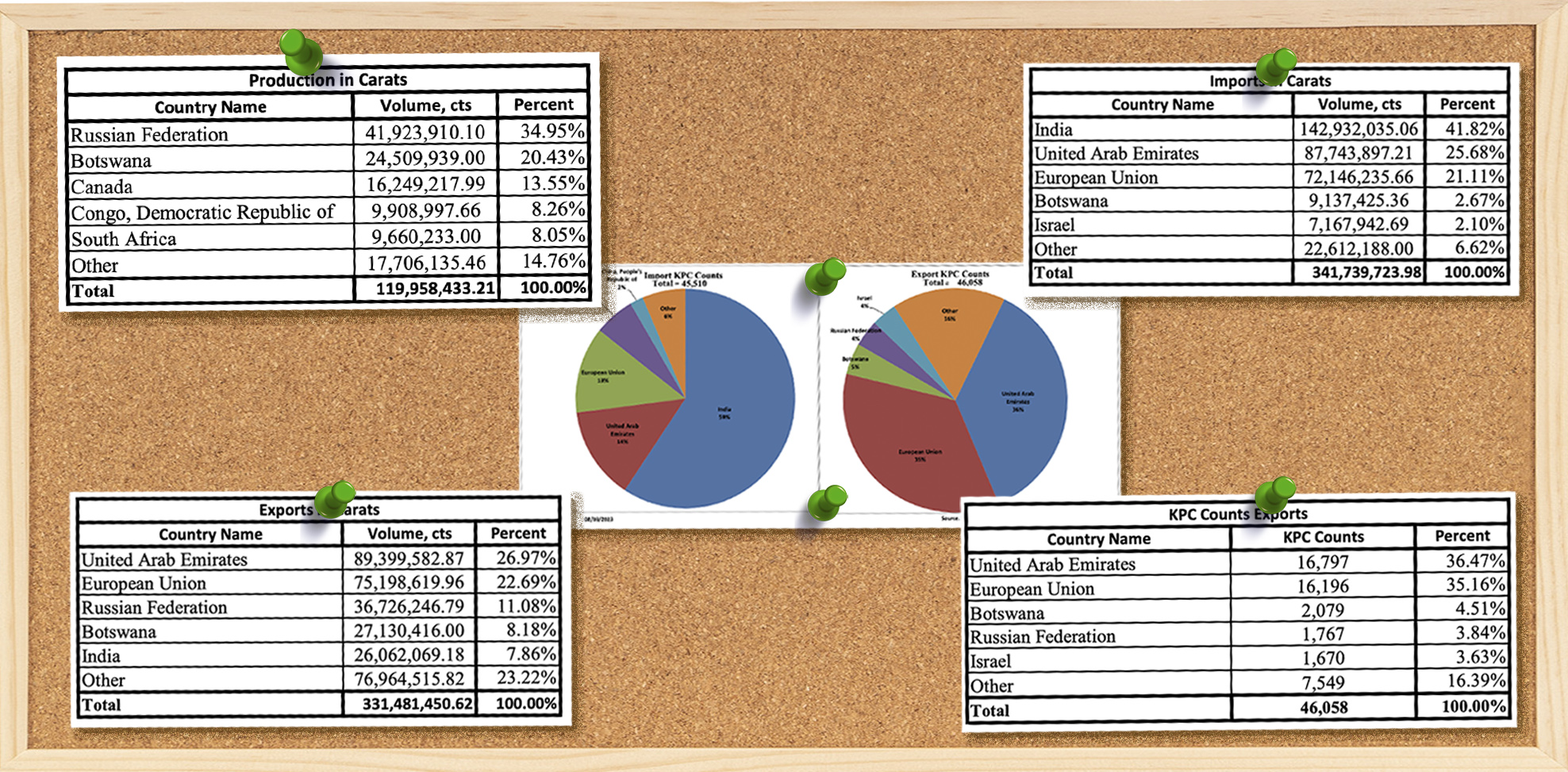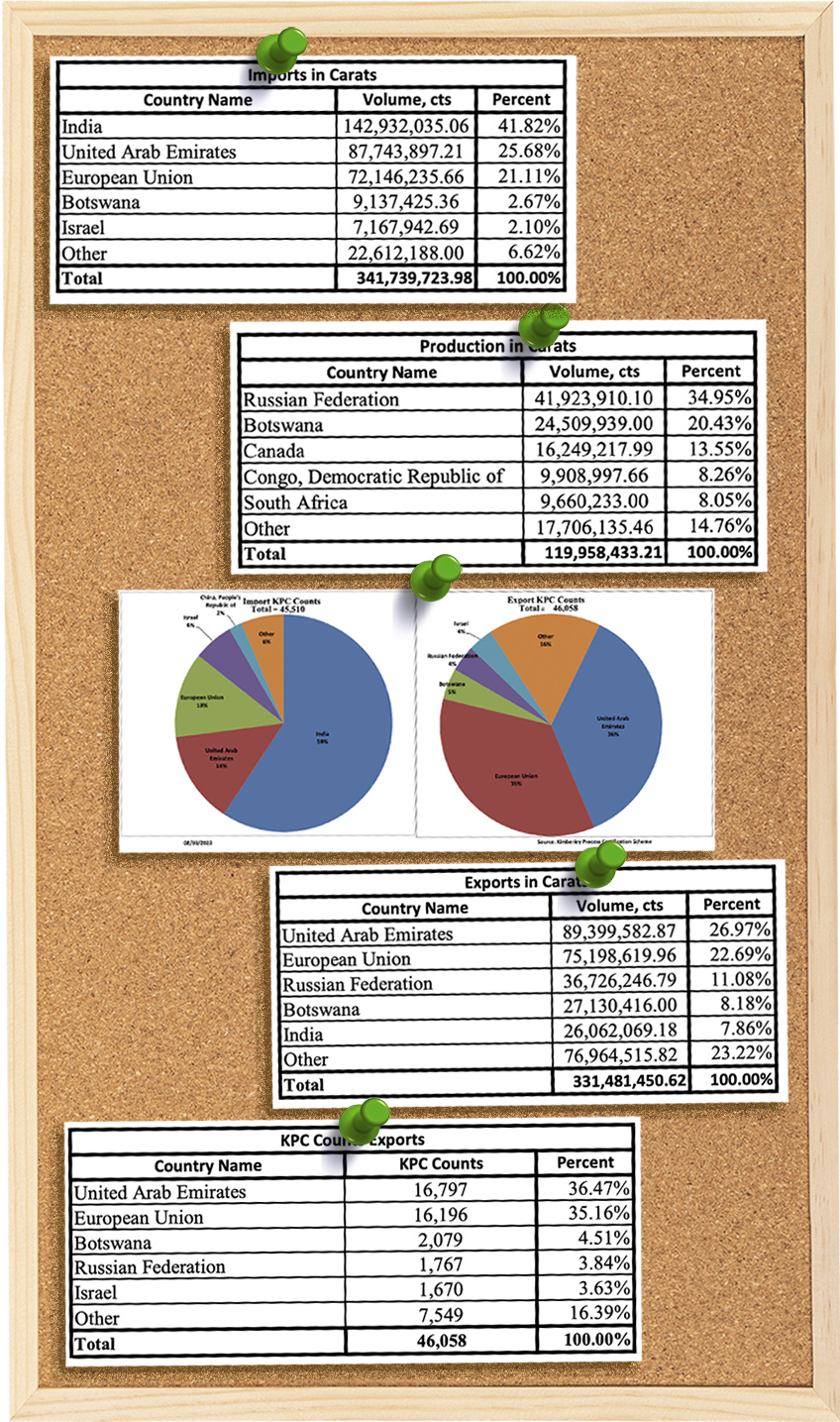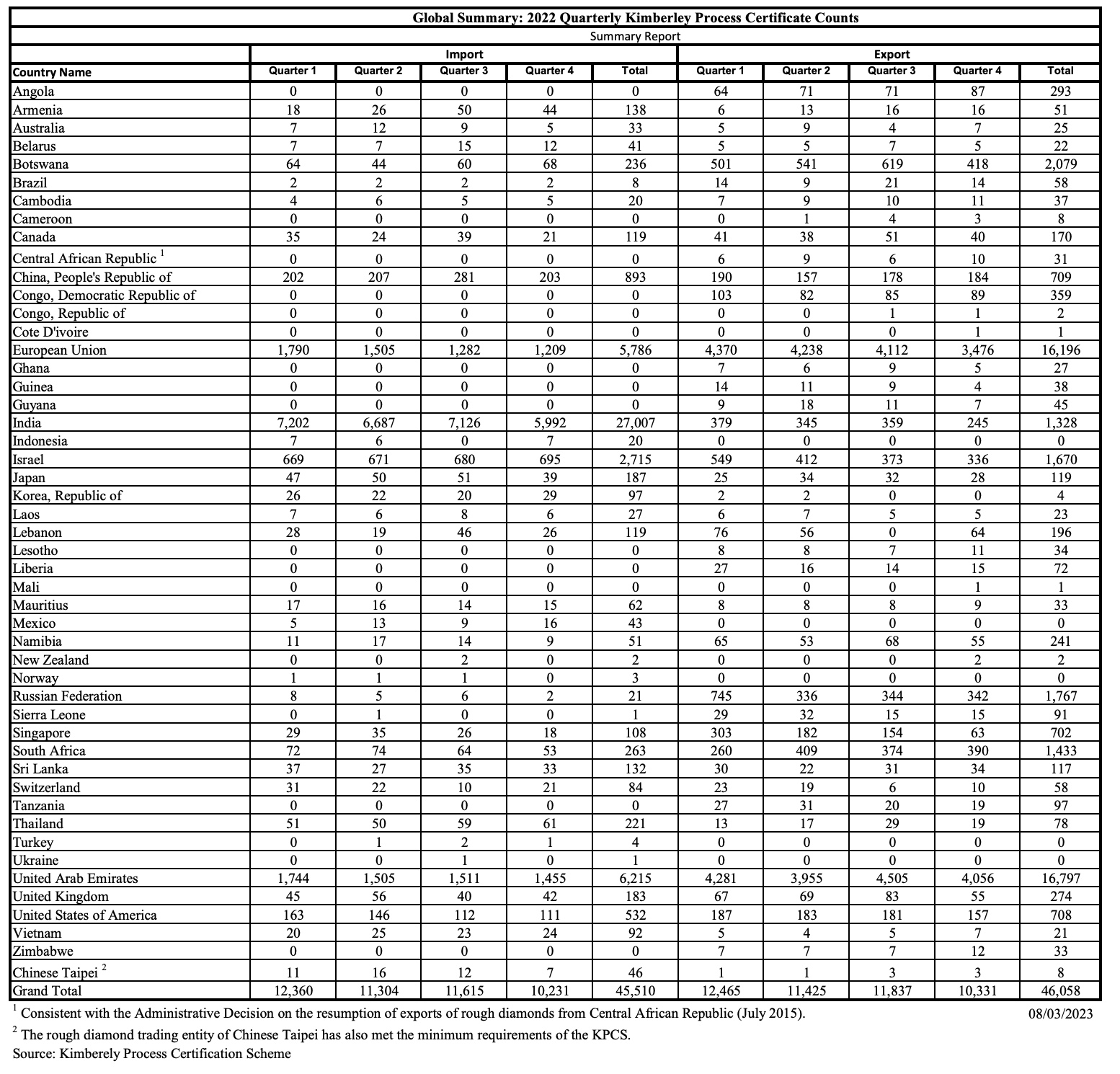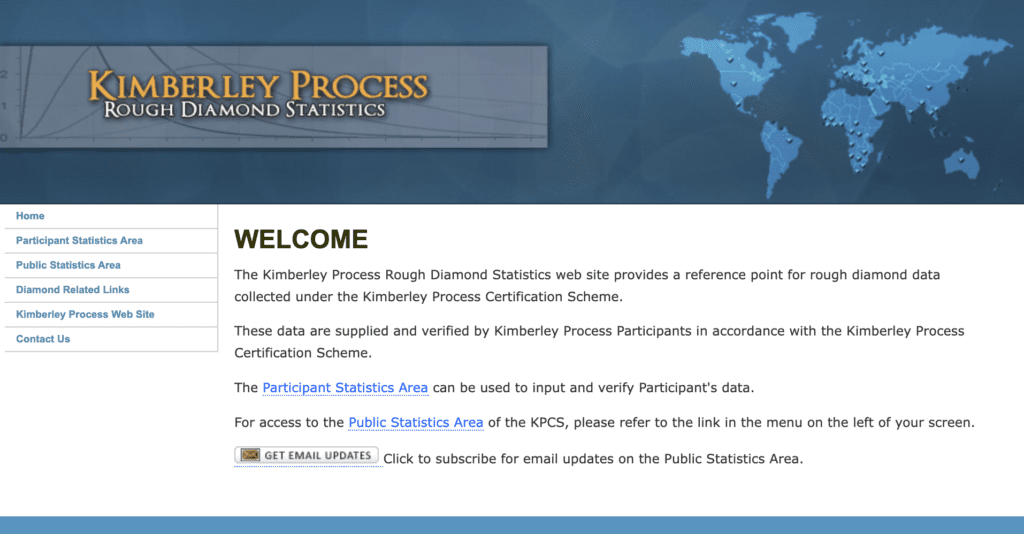Revealing the dark side of the moon:
Kimberley Process statistics



By Steven Benson,
WDC Communications
When the structure and mechanisms governing the operation of the Kimberley Process Certification Scheme were being formulated in 2001 and 2002, ahead of the system’s launch in January 2003, its architects addressed what in many respects was the dark side of the moon – the non-existence of reliable and verifiable data relating to the production and trade of rough diamonds.
At the time, the total volumes and value of rough diamonds mined and sold were essentially conjecture, since there was no sanctioned body authorized to collect and collate data from the various producing countries around the world.
For years, the overwhelming majority of goods were distributed by a single company, De Beers – upwards of 90 percent it was believed. This, it could be surmised, would make the task of reporting provenance more straightforward. But De Beers as a matter of policy aggregated its supply, and did not report the source of individual stones. In any case, in the absence of corroborating data, even the exact proportion of its dominant position in the market was impossible to verify.
So was the actual proportion of the total taken up of conflict diamonds in the rough supply. In the late 1990s and early 2000s they were estimated to be equal in value to about 4 percent of production, but that was an assessment, and it often was disputed.
In fact, not only were verified production figures not readily available, but in the case of the Soviet Union, a major producer of rough, albeit under the radar for a long while, diamonds were considered a strategic mineral, and production data was a state secret.
But the KPCS could not credibly operate without each legitimately produced diamond being properly accounted for, and thus the need for reliable statistics was understood from the outset to be of critical importance.
Reliable and comparable data
And so it was when the Kimberley Process Core Document was approved in 2002 to serve as the blueprint of the soon-to-be-launched certification scheme, statistics were expressly dealt with in Section 5 of the document, which related to cooperation and transparency among KP members. Its second clause expressly stated that each Participant government must compile and make available to all other Participants, through the KP Chair, “statistical data.”
What exactly that term entailed was elaborated upon in the same document in Annex 3, which in its preamble stated that “reliable and comparable data on the production and the international trade in rough diamonds are an essential tool for the effective implementation of the Certification Scheme, and particularly for identifying any irregularities or anomalies which could indicate that conflict diamonds are entering the legitimate trade.”
Recognizing that commercially sensitive information should be protected, Annex 3 nonetheless proposed that Participants provide quarterly aggregate statistics on rough diamond exports and imports, as well as the numbers of certificates validated for export, and also of imported shipments accompanied by KP certificates. To do so, they needed to maintain and publish statistics on exports and imports, by origin and provenance wherever possible, by carat weight and value, and under the relevant Harmonized Commodity Description and Coding System (HS) of the World Customs Organization (WCO).
Annex 3 also required that producing countries that are members of the Kimberley Process maintain and publish statistics on rough diamond production by carat weight and by value on a semi-annual basis. It added that, in the event that a Participant is unable to publish these statistics, it had to notify the KP Chair immediately.
The approval of the KP Core Document meant that all Participants agreed to make available the required production and trade data, as a condition of their membership. This meant, for example, the government of the Russian Federation, which had replaced that of the Soviet Union, was required to declassify rough diamond production totals as part of the legislative package it passed in the runup to the launch of the Kimberley Process Certification Scheme in January 2003.

End-of-year data for 2022, released on the KP Statistics website by the KP Working Group of Statistics.
The Working Group of Statistics
At the first KP Plenary meeting to take place after the certification scheme became operational, in Johannesburg, South Africa, in April 2003, an Administrative Decision describing terms of reference for a Working Group of Statistics (WGS) was adopted.
The first WGS Chair was Rob Dunn of Canada, who was representative of an official government agency, Natural Resources of Canada.
The new body was charged with overseeing the collection and compilation of reliable and comparable statistics on the production and international trade in rough diamonds, in line with the principles outlined in Annex 3 of the Core Document.
It was also tasked with developing recommendations for the consistent use of common classification systems, and in particularly the HS commodity classification codes relating to diamonds.
The new working group was set the task of creating and maintaining a website, which would allow for the direct capture of data submissions and also for the public release of the data. It is today located at https://kimberleyprocessstatistics.org/ and in many respects has become the world’s most reliable source of rough diamond production and trading statistics.
To enable the collection and analysis of data, standard means of reporting were required. At the 2004 Plenary, which met in Gatineau, Quebec, in Canada, the new working group was tasked with undertaking a study of national methodologies, in order to pinpoint elements that place constraints on the orderly production of statistics. As a result, the KP Plenary eventually adopted an Administrative Decision that insisted that Participants use Kimberley Process Certificate-based figures when submitting trade data. This, it was suggested, would improve the comparability of results provided by Participants.
The KP’s most complex task
In many respects, the collection and collation of data from all the KP participant countries was the most complex project undertaken by a single Kimberley Process body, for in most other respects the KP was able to shift administrative tasks to the national authorities in member countries. The KP Secretariat, which migrated from year to year each time a new KP Chair assumed office, lacked the infrastructure and institutional memory to manage the job.
Then, at the 2008 KP Plenary meeting in New Delhi, India, the United States government was chosen to chair the KP Working Group of Statistics. The job was assigned to the Economic Indicator Division of the U.S. Census Bureau, which is part of the U.S. Department of Commerce.
With the considerable resources at its disposal, the U.S. Census Bureau was already the gatekeeper of diamond data for the United States. Its Economic Indicator Division had been charged with collecting, compiling, and publishing import and export trade statistics and KP certificate-based statistics by the Clean Diamond Trade Act for the U.S. implementation of the Kimberley Process Certification Scheme. It had been signed into law by President George W. Bush, on April 25, 2003, less than three months after the system’s launch.
The U.S. Census Bureau was appointed Chair of the KP Working Group on Statistics on behalf of the United States of America. It is a job that they have held since January 1, 2009, to this very day.
Modus operandi of the WGS
In its capacity as WGS Chair, the U.S. Census Bureau led the working group’s efforts to improve the submission, analysis and reporting of statistical data. Its key tool is the statistics website, which was originally constructed by the U.S. team.
The WGS Chair developed the methodologies used to prepare, review and analyze the KP statistical data. They were supported by U.S. Geological Survey (USGS), which conducts reviews of statistical submissions from KP Participants as part of its technical assistance work.
The working group has also provided statistical support to the Central African Republic (CAR) Monitoring Team, which was established by the KP in accordance with the Administrative Decision on the Resumption of Exports of Rough Diamonds.
The modus operandi of WGS helps ensure that statistical inaccuracies or non-reporting not be brushed aside. Each year, at the KP Plenary meetings, the WGS reports on shortcomings by Participant countries, and these are published in the final communique that usually is issued at the end of the gathering. Habitual non-reporting is grounds for suspension or expulsion from the KP.
The WGS Chair also worked to develop a process to detect statistical anomalies, which may indicate inaccuracies in the data being reported by KP Participant countries.
Each certificate issued by a KP authority in an exporting country should be checked and accounted for by the KP authority in the importing country. If the numbers do not tally, then an anomaly is indicated. To improve the process, the WGS Chair developed and administered a survey of KP Participants’ practices in order to produce a best practice document for improved reconciliation between trading partners.
A stern test for the KP Permanent Secretariat
On November 5, 2022, the KP Plenary meeting in Gaborone, Botswana, approved the candidacy of Botswana as the site of the prospective KP Permanent Secretariat. It is projected to begin operating early in 2024.
Three years after its launch, when it is planned that new KP Secretariat will have a staff of four employees, including its Secretary General, it is hoped that the body will assume the management of KP statistics, including the dedicated website.
This will be a stern test of its proficiency, taking over from a body that for the past 14 years has enjoyed the considerable support of the U.S. government.







